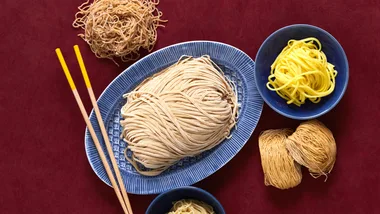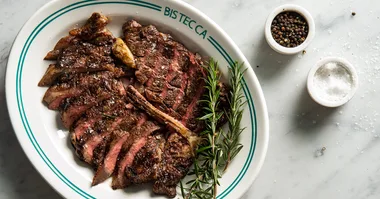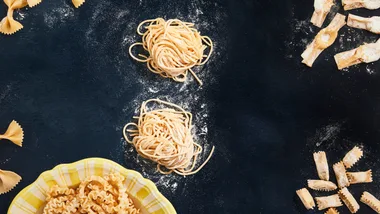Dashi is the building block for many Japanese dishes, and it’s surprisingly simple to make, requiring only a few ingredients. “It adds complexity to so many different dishes,” says Michael Ryan, owner and chef of Provenance in Beechworth, Victoria. Dashi is used as the backbone for miso soup, noodle-soup dishes like udon, soba and ramen, and chawanmushi. “It’s not a flavour on its own, but an enhancer,” he says. The simmering liquid unlocks the umami flavours of kombu, and you can also add other dried ingredients. “Once you add bonito, it’s a really defining and unique aroma of Japanese cuisine.”
Recipe by Michael Ryan, words by Jordan Kretchmer.
How to make dashi, step by step
KOMBU DASHI
Combine 20gm kombu and 2 litres cold water and leave overnight (optional, but it’s worthwhile as it’ll enhance the flavour).
The next day, slowly heat in a saucepan over medium heat to 65°C. Hold it at this temperature for 10 minutes, making sure it doesn’t come to a boil (boiling kombu can lead to undesirable flavours and bring out a gelatinous character).
When done, you should be able to pierce the kombu with your thumbnail. Remove kombu (reserve for niban dashi, a second infusion used for braises and sauces).

To make kombu dashi, soak the kombu in water overnight.
(Photo: Will Horner)BONITO ICHIBAN DASHI
Heat 2 litres kombu dashi in a saucepan over medium heat to 80°C. Add 30gm katsuobushi (dried bonito flakes), then remove from heat and infuse (3 minutes). Pass through a sieve (reserve katsuobushi for niban dashi).

Infuse your kombu dashi with katsubushi to make bonito ichiban dashi.
(Photo: Will Horner)NIBAN DASHI
Place reserved kombu and katsuobushi and 1 litre water in a saucepan over medium heat and slowly bring to 80°C. Remove from heat, add 15gm extra katsuobushi and leave for 3 minutes. Pass through a sieve (discard kombu and katsuobushi).

Strain your niban dashi and discard the kombu and katsuobushi.
(Photo: Will Horner)SHIITAKE-MUSHROOM DASHI
To make vegetarian shiitake dashi, place 50gm dried shiitake mushrooms in 2 litres cold kombu dashi and leave overnight in the fridge.
The next day, pass stock through a sieve, squeezing liquid from shiitake (reserve shiitake for another use such as in stir-
fries, braises or chawanmushi). Pass stock through muslin.
How to use dashi to make chawanmushi
Chawan translates to “teacup” and mushi to “steamed”, which is why this delicate savoury custard is often served in a small teacup (the Japanese variety without handles) as a small course in a multi-course meal. The secret to a great chawanmushi is to add just enough egg to the dashi, and to steam it just the right amount to achieve a silky texture that breaks smoothly when pierced. Chawanmushi is regarded as a soup course, as the liquid released from the added ingredients seeps out of the custard when disturbed.

1 Crack 3 eggs into a mixing bowl, lightly whisk and add 590ml dashi of your choice, 1 tbsp shoyu, 1 tsp mirin and a pinch of salt, and whisk again (do not aerate the eggs). Pass through a sieve, then strain through muslin.
2 Place your selection of garnishes (see below) into a dish or teacup (about one tablespoon per cup). Pour over custard so liquid is just shy of the top of the dish and cover tightly with a square of aluminium foil.
3 Place dish into a large steamer over medium-high heat and steam until the centre of the top of custard is just set (15 minutes).
Note Garnish with diced chicken thigh (skin off), diced raw prawns, sliced spring onion, shelled edamame or sliced mushrooms.

Place your garnishes, followed by the egg mixture, into a dish or teacup.
(Photo: Will Horner) Will Horner
Will Horner









